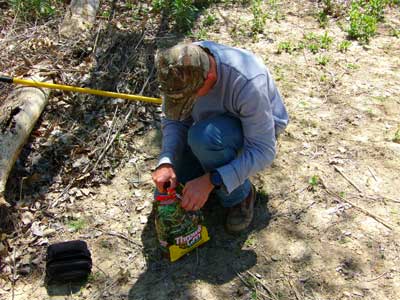I sighed. I wasn’t trying to be disrespectful, but the seminar speaker was tossing around verbiage I simply couldn’t wrap my brain around. Comments like, “Plant 20 acres of beans,” and “Make a screen plot to blanket your approach, and then plant a 10- or 15-acre green plot.” Yes, the speaker was an authority on killing big whitetails, but this information wasn’t going to help me. I don’t own acreage of my own, and even if I did, having the machinery and implements to create such slices of whitetail heaven would be just a tad bit above my paygrade.
Now, don’t tar and feather me just yet. I’m not a food plot curmudgeon. I’m not against them, and I don’t think they give bowhunters an unfair advantage. In fact, the one thing this seminar left me wanting to do was create my own food plot, but I just didn’t know how. I figured contacting the landowner for the property I bowhunt was a good start, and he agreed to let me put a small plot back in the woods away from his main agriculture fields. I started to get excited. A nice little kill plot situated in the woods would be the perfect way to whet my food plot appetite. So I did the research, did the work and am happy to share my five “down and dirty” food plot steps with you.
1. Smaller Is Better
My kill plot is small – about 20 yards long by 10 yards wide – so I didn’t go the soil-test route. I know this is a cardinal sin in the food plot world, but again, I was doing this for fun. If it worked, great. If it didn’t, I was out a little manual labor … big deal. So the first thing I did was spray my food plot with Roundup weed killer. The thing I like about Roundup is that it kills everything.
Related: Plant Professional Food Plots Every Time (Video)
2. Sweat Equity, But Not Too Much
After giving my chemical a couple of weeks to do its job, I returned with three must-have food plot manual labor items: a garden hoe, a steel rake and a shovel. Start by raking away the leaves and withered vegetation. Next, use the shovel and hoe to loosen the top soil. You don’t need to go too deep, and I find that most of the time the hoe is more than enough to accomplish this task.
3. Don't Bury The Seed Too Deep

After loosening the soil, I once again like to rake the soil and smooth it out. This also removes any additional dead weeds or leaves you may have turned up during the soil-loosening phase. Now simply use your hand or a small seed spreader to broadcast your seed. NOTE: Most food plots fail because the seed gets buried too deep. You want most of your seed just under the soil, and if you’re using an easy-to-germinate blend like wheat or Evolved Harvest’s Throw & Gro, simple soil contact is often enough to germinate. Another reason these types of plots fail is due to birds. Sparrows, black birds and the like will pick the seed from your plot faster than a jack rabbit on a date. You’re not drilling this seed with farm machinery, so there is simply no way to get around this. You’re going to lose some of your seed to the birds. To combat this, I typically spread twice the recommended amount of seed.
4. Keep The Birds Away
Wear flat-bottomed boots and walk the seed into your plot. This is another way to prevent the birds from getting at your seed, and it makes them work for the pieces they do rob. Walking in the seed with boots also creates positive seed-to-soil contact.
Related: Food plot and land management products
5. Fertilizer...Use It
Lastly, spread a little fertilizer on your plot. I’ve had great success with Expert Gardner Lawn Fertilizer (purchased at Walmart).
That’s it. You’re done. Now pray for rain and watch your little kill plot come to life.






